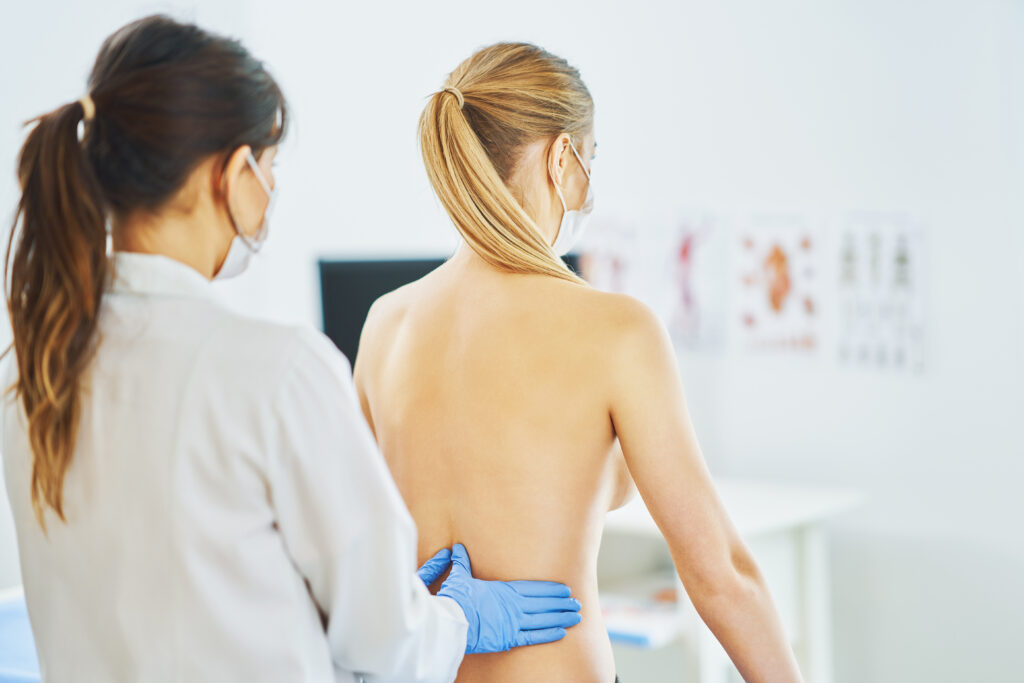People often assume scoliosis peaks during adolescence. And while that’s true for many, scoliosis and menopause are not wide apart from each other. Estrogen modulates many of a woman’s bodily functions. So, when it begins to decline during perimenopause, the drop in this critical hormone can affect your bone health and structure.
Caring for yourself well during the menopause transition requires dedicating extra attention to your bones to recognize early scoliosis signs and symptoms.
What Is Scoliosis?
Scoliosis causes the spine to curve in the shape of an “S,” which can restrict movement and cause pain. Healthcare professionals use a specific measurement called a Cobb angle to determine how much the spine curves. A curvature of over ten degrees indicates scoliosis. Other primary symptoms of scoliosis include:
- Visibly uneven shoulders or hips.
- Difficulty breathing while sitting.
- Fatigue from standing for long periods
Most women receive a scoliosis diagnosis during their teen years; about 80% are diagnosed between the ages of 10 and 20. Yet even without a prior history of scoliosis, about 30% of women in their early to mid-60s could receive a scoliosis diagnosis.
Types of Menopause-Related Scoliosis
Women who develop scoliosis during the menopause transition fall into one of two categories: adult idiopathic or degenerative scoliosis. Idiopathic scoliosis refers to a prior scoliosis diagnosis, often during adolescence, that reoccurs or worsens during menopause due to loss of regulating estrogens.
Degenerative scoliosis, also known as adult-onset scoliosis, develops in women around age 65 and first forms in the lower parts of the spine (the lumbar region) and tends to stay hidden. Women report hip pain, often on the right side, as the first sign of degenerative scoliosis. Besides fluctuating hormones, some women may be more at risk for adult degenerative scoliosis due to family history or other related musculoskeletal conditions.
Keep in mind that clinical exams and scans alone cannot distinguish between the two types of scoliosis in postmenopausal women. That’s why it’s critical to report an accurate medical history to your healthcare provider.
Other Conditions that May Contribute to Scoliosis During Menopause
Your hormones, estrogen in particular, help maintain sufficient bone density levels. As estrogen declines during perimenopause and postmenopause, your risk of developing other conditions that can lead to scoliosis increases as bone loss speeds up.
Osteoporosis makes bones weak and fragile, and is a common issue for many women after menopause. It can also increase the risk of developing a curved spine as lower estrogen levels make it harder for your body to keep your spine straight and prevent it from curving. A habit of poor posture, for instance, can put just enough pressure on your spine that a habitual slump can become permanent as you lose bone density.
However, people with scoliosis are often left out of important osteoporosis studies, so it’s difficult to know if typical osteoporosis treatments would be effective. Plus, it’s unclear if postmenopausal women with osteoporosis are more likely to have scoliosis compared to others their age.
Arthritis can make spinal curves worse and may lead to scoliosis. This occurs because arthritis causes ongoing weakness, inflammation, and damage to the spinal bones. Scoliosis and arthritis can also feed off each other. The abnormal curve of the spine from scoliosis can put uneven pressure on the spinal joints, which causes arthritis. And in turn, arthritis can worsen scoliosis symptoms by making it harder to move your spine.
How to Prevent Scoliosis and Bone Loss During Menopause
Entering the menopause transition calls for regular screenings and scans because your hormones impact key systems like your heart, lungs, and, of course, your bones.
Most healthcare professionals recommend a regular bone density test, also called a DXA or “DEXA” scan, to protect against bone density loss and monitor bone health. A DEXA scan “measures the thickness and strength of bones using high-energy X-rays, and can detect osteoporosis or bone thinning.” Regular bone density scans also allow your provider to track your bone health and catch any early or significant declines in bone density and signs of scoliosis.
Prioritizing a healthy diet can also boost your bone strength. Minerals like calcium and Vitamin D are vital for bone health, and maintaining a diet high in each can help prevent further or rapid bone density loss. Aim to add more eggs, dairy, salmon, and leafy greens like broccoli to your meals.
Regular exercise, particularly weight-bearing or strength training workouts, also helps build muscle to support your bones. Another positive side effect? These types of exercises can also influence bone density. Some women also report that regular yoga keeps their muscles flexible and limber and that the various poses stretch and strengthen their core muscles for better spine support.
Maintaining good posture throughout the day and using ergonomic (which means “comfort at work”) chairs or supports if you sit for long hours can help prevent spinal curves. Certain therapies, such as hydrotherapy and physiotherapy, may also benefit women with or at risk for scoliosis.
